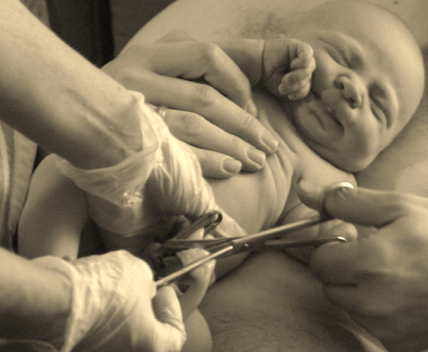Cord-clamping – shortly after birth?
... your baby needs time to get breathing under way
In Germany, a guideline recommends that childbearing women decide. They can choose whether the umbilical cord should pulse out or whether it may be clamped for between 1 and 5 minutes. Foto: Nicole Ebrecht-Fuß
Foto: Nicole Ebrecht-Fuß
In the womb, the baby's blood flows through the umbilical cord to and from the baby and the placenta brings oxygen to the baby from the mother's blood. If the umbilical cord is left unclamped for some time after birth, the blood from the placenta passes to the baby to increase the baby's blood volume and help the flow of blood to the baby's important organs including the lungs.
For babies to adapt well after birth it is important, to have a continuous blood supply. That way adjusting to the new surroundings and breathing through the lungs can begin without fear and breathing problems. Clamping the cord shortly after birth, creates unnecessary risks for the baby.
We know the feeling of being under water or holding your breath too long and not having enough air left. That’s how it feels for the newborn.
To gain umbilical cord blood, the cord has to be cut in less than 30 seconds after birth. This way the newborn loses at least one third of his entire blood amount. So there will be not enough oxygen available, your baby might undergo fear of suffocation. Things like that will be memorized for life: fear = not being able to breathe.
In 1924 they already found correlation between early cord-clamping and asthma.A Danish study about respiratory diseases after Caesarean shows a four-fold higher risk for babies to develop respiratory diseases within their first year.
